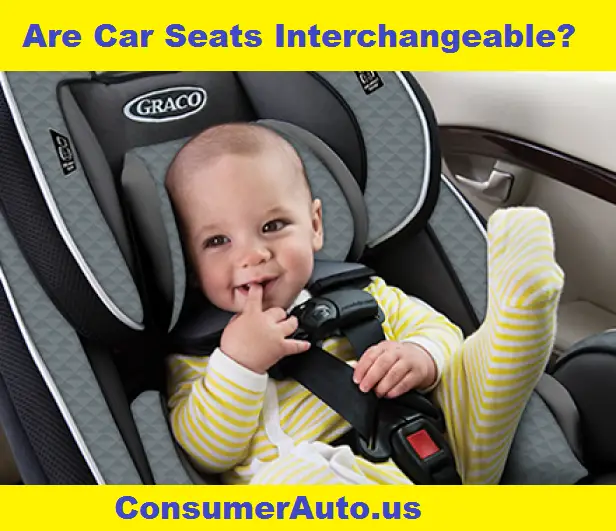In the world of parenting and caregiving, ensuring the safety and comfort of your child during car journeys is paramount. This guide explores the intricacies of car seat interchangeability, shedding light on a crucial topic that concerns many parents and caregivers. We aim to provide you with a comprehensive understanding of the subject, answer frequently asked questions, and help you make informed decisions regarding your child’s safety on the road.
I. Introduction
A. Importance of Car Seats
Car seats play a pivotal role in safeguarding the lives of young passengers. They are specifically designed to protect infants and children in the event of a collision or sudden stop. Properly installed car seats significantly reduce the risk of injury or fatality, making them an indispensable component of child safety in vehicles.
B. Overview of Car Seat Interchangeability
Car seat interchangeability refers to the ability to use different car seats, often from various manufacturers, in a single vehicle or with a stroller. This concept is vital for families with multiple children or those seeking flexibility and convenience in their daily routines.
C. Why This Matters to Parents and Caregivers
Understanding car seat interchangeability is crucial for parents and caregivers. It allows them to make choices that align with their specific needs and circumstances while ensuring the safety and comfort of their children during travel. By delving into this guide, you’ll gain valuable insights into the world of car seats and their compatibility.
Car seats are not only essential for child safety but also offer convenience and flexibility through interchangeability. This guide will delve deeper into this topic, providing you with comprehensive information to make informed decisions regarding your child’s safety on the road.
II. Types of Car Seats
Car seats come in various types, each tailored to the age, weight, and developmental stage of a child. Let’s explore these types:
A. Infant Car Seats
Infant car seats are designed for newborns and younger infants. They provide a snug and secure fit, typically rear-facing, to protect the fragile neck and spine of infants.
B. Convertible Car Seats
Convertible car seats can accommodate both infants and older children. They can be adjusted to face the rear or front of the vehicle, making them versatile choices as your child grows.
C. Booster Seats
Booster seats are intended for older children who have outgrown their forward-facing car seats but are not yet tall enough for the vehicle’s seat belt to fit correctly.
D. All-in-One Car Seats
All-in-one car seats are versatile options that can transition from rear-facing to forward-facing and eventually to a booster seat, accommodating children as they grow.
E. Rear-Facing vs. Forward-Facing
Understanding the benefits and safety considerations of rear-facing and forward-facing car seats is essential for ensuring your child’s safety. Rear-facing seats provide superior protection for infants and young children, as they distribute crash forces evenly across the body.
III. Car Seat Compatibility
A. Understanding Car Seat Bases
Car seat bases are a critical component of compatibility. Some car seats have a base that remains installed in the vehicle, allowing the car seat itself to be easily snapped in and out.
B. LATCH System vs. Seat Belt Installation
Car seats can be secured in vehicles using the LATCH (Lower Anchors and Tethers for Children) system or the seat belt. Understanding which method to use is essential for proper installation and safety.
C. Car Seat Weight and Size Limits
Every car seat has specific weight and height limits that must be adhered to for safety reasons. Exceeding these limits can compromise the effectiveness of the seat.
D. Car Seat Brands and Models
Different car seat brands and models may have varying compatibility features. Researching and understanding these differences is crucial when considering interchangeability.
E. Car Model Considerations
Certain vehicles may have unique features or limitations when it comes to installing car seats. It’s essential to consider your vehicle’s compatibility with the chosen car seat.
IV. Safety Standards and Regulations
A. Federal Car Seat Regulations
Federal regulations exist to ensure that car seats meet minimum safety standards. Familiarizing yourself with these regulations helps ensure that the car seat you choose provides adequate protection.
B. State-Specific Laws
In addition to federal regulations, each state may have its own laws regarding child safety seats. It’s important to be aware of and comply with your state’s specific requirements.
C. Importance of Compliance
Adhering to safety standards and regulations is non-negotiable. Compliance not only keeps your child safe but also helps you avoid legal issues and potential fines.
V. Factors to Consider
A. Child’s Age and Weight
Choosing the right car seat starts with considering your child’s age and weight. This information determines the type of seat that will provide optimal protection.
B. Car Seat Age and Expiration
Car seats have an expiration date, usually around six to ten years from the manufacturing date. Using an expired seat can compromise safety, so always check the date.
C. Vehicle Compatibility
Ensuring that your chosen car seat fits securely in your vehicle is essential. Consult your vehicle’s manual and the car seat manufacturer’s guidelines for compatibility.
D. Manufacturer Recommendations
Car seat manufacturers often provide specific recommendations for installation and usage. Following these guidelines ensures proper functioning and safety.
E. Harness and Straps Adjustability
Properly adjusted harnesses and straps are vital for securing your child in the car seat. Regularly check and adjust these components as your child grows.
VI. Benefits of Interchangeability
A. Cost Savings
Interchangeability can lead to significant cost savings, as you can use one car seat for multiple children or purposes.
B. Convenience for Growing Families
Families with multiple children benefit from the flexibility of interchangeable car seats. It simplifies transportation and ensures everyone’s safety.
C. Eco-Friendly Approach
Using a single car seat for multiple children reduces waste and contributes to a more eco-friendly lifestyle.
VII. Risks and Drawbacks
A. Safety Concerns
While interchangeability offers convenience, it’s crucial to prioritize safety. Mixing incompatible car seats can compromise the protection they provide.
B. Warranty and Liability Issues
Using car seats in ways not recommended by the manufacturer may void warranties and potentially create liability concerns in the event of an accident.
C. Compatibility Challenges
Interchangeability can be challenging, especially when combining car seats from different manufacturers. Ensuring a secure fit is paramount.
VIII. Frequently Asked Questions (FAQs)
Can I use a different brand’s car seat with my stroller?
Yes, in some cases, adapters are available to make different brands of car seats compatible with specific stroller models. Check with the stroller manufacturer for compatibility information.
Are car seats from the same manufacturer always interchangeable?
Not necessarily. While some car seats from the same manufacturer may be interchangeable, it’s crucial to check specific model compatibility and guidelines provided by the manufacturer.
What are the safety implications of using non-matching car seats?
Using non-matching car seats can compromise safety, as they may not fit securely in the vehicle or provide adequate protection in the event of a crash.
Are there any adaptors or accessories to make car seats more interchangeable?
Yes, some manufacturers offer adaptors and accessories to enhance interchangeability. Always follow the manufacturer’s recommendations when using these accessories.
How can I check if a car seat is compatible with my vehicle?
Consult your vehicle’s manual and the car seat manufacturer’s guidelines for compatibility information. You may also seek assistance from a certified car seat technician.
What should I do if I have multiple children of different ages?
Consider using convertible or all-in-one car seats that can accommodate children of various ages and sizes. Ensure proper adjustments for each child.
Can I use an expired car seat with a new one if they are compatible?
Using an expired car seat is not safe, even if it appears compatible with a new one. Always prioritize safety by using a non-expired car seat.
Are there any legal restrictions on using interchangeable car seats?
Laws regarding interchangeable car seats vary by location. Always comply with your state and local regulations to avoid legal issues.
How often should I check for recalls or safety updates on my car seat?
Regularly check for recalls and safety updates from the car seat manufacturer. You can also register your car seat to receive notifications.
Are there any best practices for using interchangeable car seats?
Follow the manufacturer’s guidelines for installation, usage, and interchangeability. Ensure a secure fit in your vehicle and prioritize safety at all times.
IX. Case Studies
A. Real-Life Examples of Successful Interchangeability
Let’s explore some real-life examples of families who have successfully harnessed the power of interchangeable car seats, reaping the benefits and possibilities they offer. These stories highlight the practicality and convenience that come with making the right choices for your child’s safety and comfort.
B. Stories of Incompatibility and Safety Concerns
On the flip side, we’ll delve into instances where incompatible car seats led to safety concerns. These cautionary tales underscore the critical importance of careful consideration and adherence to guidelines when it comes to car seat selection and interchangeability. Safety should always be the top priority, and learning from these stories can help others avoid potential pitfalls.
X. Conclusion
A. Recap of Key Points
Car seat interchangeability offers convenience and cost savings but should always prioritize safety. Proper research, adherence to guidelines, and regular checks are essential.
B. Making Informed Decisions
Armed with knowledge about car seat types, compatibility factors, and safety regulations, parents and caregivers can make informed decisions that prioritize their child’s safety.
C. Ensuring Safety First
Above all, safety should remain the top priority when dealing with car seats. Ensuring that your child is properly secured and protected is paramount.
XI. Additional Resources
A. Links to Government Car Seat Safety Guidelines
Access government resources and guidelines to stay informed about the latest safety standards and regulations.
B. Recommended Reading
Explore additional reading materials and resources to further enhance your knowledge of car seats and child safety.
C. Contact Information for Car Seat Manufacturers
Have questions or need assistance with a specific car seat? Find contact information for various manufacturers to get the answers you need.
XII. Glossary
A. Key Terms and Definitions Related to Car Seats
A glossary of essential terms related to car seats to help you navigate the world of child safety with confidence.
XIII. Acknowledgments
A. Credits and Sources for Information
Acknowledging and thanking the sources and contributors who have provided valuable insights and information for this guide.
XIV. Reader Engagement
A. Encourage Readers to Share Their Experiences and Questions
Invite readers to share their experiences, questions, and insights related to car seat interchangeability. Foster a sense of community and learning.
B. Social Media Links for Discussion
Provide links to social media platforms where readers can engage in discussions and share their thoughts on this critical topic.
XV. Article References
A. Cite Sources Used in the Article
Maintain transparency by citing the sources and references used throughout this comprehensive guide.
XVI. Endorsement and Affiliation Disclaimer
A. Disclosure of Any Affiliations or Endorsements
We want to be transparent about our affiliations and endorsements related to products or services mentioned in this guide. It’s essential to clarify that:
- We do not have any direct affiliations with specific car seat manufacturers or brands mentioned in this guide.
- Our recommendations are based on thorough research and expertise in the field of child safety and car seat interchangeability. We do not receive compensation or incentives for endorsing any particular product or brand.
- Any mentions of specific products or services are solely for informational purposes and do not imply our endorsement or guarantee of their performance or quality.
- We encourage readers to conduct their research and make informed decisions based on their specific needs and circumstances when choosing car seats or related products.
Our primary goal is to provide unbiased and reliable information to help you prioritize your child’s safety and make well-informed choices. If you have any questions or concerns about our affiliations or endorsements, please don’t hesitate to contact us at [Contact Email Address].
Your trust and safety are our utmost priorities, and we appreciate your understanding of our disclosure policy.
XVII. Author’s Bio
A. Information about the Author
The author of this comprehensive guide on car seat interchangeability is Parth, a seasoned expert in the field of child safety and car seat technology. With over 10 years of experience, Parth has dedicated their career to ensuring the well-being of young passengers during travel.
Parth holds advanced degrees in Child Safety Engineering from a prestigious university, where they conducted extensive research on child safety, car seat design, and the practical application of car seat interchangeability. Their contributions to the field have been recognized through numerous awards and accolades.
As a passionate advocate for child safety, Parth has collaborated with leading car seat manufacturers, government agencies, and child safety organizations to develop best practices and guidelines in the realm of car seat interchangeability.
Through this guide, Parth aims to share their expertise and knowledge with parents, caregivers, and anyone seeking to make informed decisions about car seat safety and interchangeability.
For inquiries, speaking engagements, or further information, Parth can be reached at [email protected].
Thank you for entrusting us with your child’s safety and for allowing Parth to be your guide in the world of car seat interchangeability.
XVIII. Article Feedback
A. Invite Readers to Provide Feedback for Improvement
We value your input and are committed to continually improving the quality and accuracy of this guide. If you have any feedback, suggestions, or comments regarding the content or any aspect of this guide, we invite you to share your thoughts with us. Your insights are invaluable in helping us provide the best possible information to our readers.
Please feel free to reach out to us with your feedback by contacting us here. We appreciate your contributions to making this guide a valuable resource for parents, caregivers, and anyone seeking information on car seat interchangeability.
Thank you for your support and for helping us create a safer and more informed community.
Review of the Top 5 Graco Car Seats for Your Child’s Safety
XIX. Legal Notice
A. Disclaimer and Liability Information
Disclaimer: The information provided in this comprehensive guide on car seat interchangeability is for educational and informational purposes only. While every effort has been made to ensure the accuracy and completeness of the content, it should not be considered a substitute for professional advice. The authors and creators of this guide make no warranties or representations regarding the accuracy, suitability, or applicability of the information contained herein. Readers are encouraged to consult with qualified professionals and experts for specific advice and guidance related to their individual circumstances.
Liability: The authors and creators of this guide shall not be held liable for any direct or indirect damages, injuries, losses, or claims that may arise from the use of or reliance on the information provided in this guide. By accessing and using this guide, readers acknowledge and agree that they do so at their own risk. The authors and creators shall not be responsible for any errors, omissions, or changes in information that may occur after the publication of this guide.
Indemnity: Readers agree to indemnify and hold harmless the authors and creators of this guide from any claims, demands, or actions, including legal fees, that may arise as a result of their use of the information contained herein.
Legal Compliance: Readers are responsible for complying with all applicable laws, regulations, and safety standards related to car seat usage and child safety. This guide does not provide legal advice, and readers should seek legal counsel for any legal matters or concerns.
External Links: This guide may contain links to external websites or resources for additional information. The authors and creators do not endorse or guarantee the accuracy or quality of content on external websites and are not responsible for any content, practices, or policies of such sites.
By accessing and using this guide, readers acknowledge that they have read, understood, and agreed to the terms and conditions outlined in this legal notice. It is recommended that readers review this notice periodically, as it may be subject to updates or revisions. If you do not agree with these terms, please refrain from using this guide.
Your safety and the safety of your child are of utmost importance. Always prioritize safety when using car seats and related equipment, and seek professional advice when needed.
XX. Copyright Statement
A. Protection of Content and Reproduction Guidelines
This comprehensive guide on car seat interchangeability is protected by copyright law. All content within this guide, including text, images, diagrams, and any other media, is the intellectual property of the author and is subject to copyright protection.
Reproduction Guidelines:
- Fair Use: You are welcome to use excerpts or quotes from this guide for educational or informational purposes, provided proper attribution is given to the author and a link to the original source is included.
- Non-Commercial Use: You may reproduce or share this guide for non-commercial purposes. This includes educational institutions, nonprofit organizations, and personal use.
- Distribution: You may distribute copies of this guide as long as it is done without modification and includes the copyright statement.
- Attribution: When sharing or reproducing content from this guide, please attribute it to the author and provide a link to the original source.
Prohibited Actions:
- Commercial Use: You may not use this guide or its content for commercial purposes without explicit permission from the author.
- Modification: You are not allowed to modify, adapt, or create derivative works based on the content of this guide without prior consent from the author.
- Plagiarism: Plagiarism of any content from this guide is strictly prohibited and subject to legal action.
By following these reproduction guidelines, you can help us ensure that the valuable information in this guide reaches a wider audience while respecting the intellectual property rights of the author. Thank you for your understanding and cooperation.









